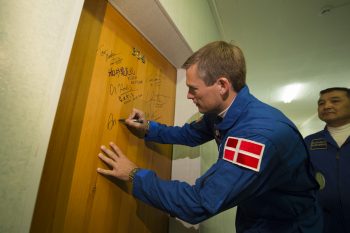On the day of launch, ESA astronaut Thomas Pesquet has a fixed schedule that will lead him to the Soyuz MS-03 rocket together with NASA astronaut Peggy Whitson and commander Oleg Novistky. This blog post shows the steps to launch and beyond. All times will be in local Baikonur times, subtract five hours for Central European Time

ESA astronaut Andreas Mogensen signs the door of his hotel room before launch September 2015. Credits: ESA
The trio get ready to leave their Cosmonaut Hotel rooms at 19:30 local time (14:30 CET) and sign the door to their rooms leaving their mark with the many cosmonauts and astronauts that have preceded them. Their guests leave at 20:00 (15:00 CET) leaving the crew a last half hour of privacy before they leave for the bus at 20:30 (15:30 CET).
The ‘space bus’ brings the crew to ‘Building 254’ where they will don their Sokol suits that protect the Soyuz astronauts from loss of pressure or fire. The Sokol suit is designed to be worn in a sitting position making it difficult to walk – you will see the astronauts hunched over as they make their way to the Soyuz spacecraft. The suit is folded and tied together with elastic bands to ensure it does not leak, watch the video below for a demonstration. As it can be quite warm inside, each astronaut carries a small battery-powered ventilator with them with a hose that attaches to the suit to provide air circulation.
Five hours before launch at 21:20 (16:20 CET) technicians start the Soyuz-rocket fueling-process while the astronauts check their suits for leaks and flight surgeons record their medical data. Four hours before launch liquid oxygen is pumped into the Soyuz rocket’s boosters.
At 23:20 (18:30 CET), three hours before launch, the astronauts leave for the launchpad with the trip from building 254 taking around 25 minutes. The crew give a salute before walking to a lift that takes them to the top of their 50 m-tall rocket.
Once inside the small Soyuz spacecraft, Oleg, Thomas and Peggy will set up communications with the launch control centre, two hours before launch. Their friends and families go for breakfast before heading to the viewing site.
For the astronauts the final two hours are spent waiting for the fuel to load, checking systems and ensuring everything is ready. As they wait and prepare they listen to music that is chosen beforehand. You can listen to Thomas Pesquet’s choice here.
The hatch is closed at L-1:45 before launch. One hour later the service structure is partially lowered, and leak tests are done while the flight procedures are prepared.
Thirty minutes before launch the emergency escape system is armed. Five minutes later the service towers are lowered. Seven minutes before liftoff all pre-launch operations are completed with the automatic launch program activated a minute later.
Five minutes before liftoff the Soyuz spacecraft takes full control and Thomas, Peggy and Oleg close their helmets. Final fueling of the oxidiser and nitrogen completes two minutes before launch and the Soyuz switches to internal battery-power one minute before launch.
At twenty seconds before liftoff the launch command is given with the umbilical cords attached to the rocket being released. Five seconds before liftoff the rocket is firing at full thrust.
Liftoff
The Soyuz launcher delivers 26 million horse-power to reach an orbital speed of 28 800 km/h. After the engines ignite they will propel the trio 1640 km in less than 10 minutes – averaging a 50 km/h increase every second for nine minutes.
There are three stages to reaching Earth orbit with the Soyuz rocket, each referring to a part of the rocket that uses its fuel and is then ejected to fall back to Earth. The iconic four boosters are called the first stage. It takes only two minutes for them to burn up and deliver their thrust – by this time Thomas, Peggy and Oleg will be flying 41 km high travelling at 8300 km/h and have travelled 39 km over land.
Roughly 30 seconds later the fairing and escape system is jettisoned too. The second stage has been firing all this time but runs out of fuel at roughly five minutes after liftoff. The second stage is ejected at a height of 176 km above Earth (they will have entered space by now) leaving the trio travelling at a speed of around 13 500 km/h. In just five minutes they will have travelled 500 km over land – imagine leaving Paris and arriving in Marseille five minutes later!
After the second stage is ejected the third stage ignites to give the final thrust to push our astronauts out of gravity’s reach. At almost nine minutes after liftoff the intense acceleration comes to an end when the third stage stops firing and falls back to Earth. With a final jolt the astronauts will feel weightless and be flying in space enroute to the Space Station!








Discussion: no comments